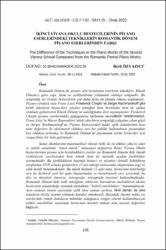| dc.contributor.author | Özyazıcı, Beril | |
| dc.date.accessioned | 2023-08-29T09:16:26Z | |
| dc.date.available | 2023-08-29T09:16:26Z | |
| dc.date.issued | 28.01.2022 | en_US |
| dc.identifier.citation | Özyazıcı, B. (2022). İkinci Viyana Okulu Bestecilerinin Piyano Eserlerindeki Tekniklerin Romantik Dönem Piyano Eserlerinden Farkı . Afyon Kocatepe Üniversitesi Akademik Müzik Araştırmaları Dergisi , VIII (15) , 145-158. | en_US |
| dc.identifier.uri | https://dergipark.org.tr/tr/pub/amader/issue/68537/1030547 | |
| dc.identifier.uri | https://hdl.handle.net/11630/10346 | |
| dc.description.abstract | Romantik Dönem’de piyano için bestelenen eserlerin teknikleri, Klasik Dönem’e göre yapı, form ve eşliklendirme yönünden oldukça zengindir. Bu zenginliği ise virtüöz bestecilerin çok daha fazla ön planda olması sağlamıştır. Piyano virtüözü olan Franz Liszt, Frederick Chopin ve Sergei Rachmaninoff gibi farklı ulusların bestecileri, piyano tekniğini hem besteleme hem de çalma yönünde geliştirerek Klasik Dönem’in sadeliğinden ileri taşımışlardır. Frederick Chopin piyano eserlerindeki appagiatura kullanımı melodilerin renklenmesini, Franz Liszt’in Macar Rapsodileri’ndeki akorların zenginliği çalgıdan çıkan gücü ve Sergei Rachmaninoff’un Piyano Konçertoları’ndaki eşlik dokularının kısa nota değerleri ile süslenerek oldukça seri bir şekilde kullanılması piyanodaki hızı oldukça arttırmış ve Romantik Dönem’de piyanonun yerini besteciler için vazgeçilmez bir hale getirmiştir. Sanat Akımlarının matematiksel olarak belki de en dikkat çekicisi olan ve müzik sanatında “tonal müzik” anlayışını değiştiren İkinci Viyana Okulu bestecilerinin piyano için besteledikleri eserler ise Romantik Dönem’deki büyük virtüözlerin eserlerinden hem teknik hem de melodik açıdan farklılıklar içermektedir. Bu farklılıkların başında besteci ve piyanist Arnold Schönberg tarafından 1919 yılında geliştirilen 12 ton müziği sonrasında oluşturulan ezgi ve eşlik motifi bulunmaktadır. Bu müzik türünde 12 adet nota, bestecinin belirlediği sıra ile dizilerek yeni bir gam oluşturmakta ve bestelenecek eser içerisinde bu dizi ve türevleri (inverse, retrograde, retrograde inverse) kullanılmaktadır. Romantik Dönem’deki halk müziğinin etkilerini barındıran melodilerin aksine bestecinin oluşturduğu sistemde melodinin “belirli sınırlılıkları” bulunmaktaydı. Aynı notasal sistem sayesinde eşlik kimi zaman serbest, kimi zaman da yine notaların diziliş sistemi yönünde hareket etmekteydi. Buradaki önemli nokta ise eserlerdeki ritmik dokuların mümkün olduğunca zengin olarak kullanılmasıydı çünkü sınırlılıklar sayesinde bestecinin hareket imkanı yine sayısal değerlere bağlıydı. Çalışmanın esas konusu olan İkinci Viyana Okulu bestecilerinin piyano eserlerinde olan farklılıkların Romantik Dönem’den farkları elde edilen veriler ve analizler ile ortaya çıkarılmak istenmiş, Romantik akımın ve Ekspresyonizm akımının piyanoya olan etkileri kaynaklar doğrultusunda değerlendirilmek istenmiştir. | en_US |
| dc.description.abstract | The best exhibited works for piano in the Romantic Period are rich in works, forms and visualizations compared to the Classical Period. This is why virtuoso composers should be in the foreground much more. Composers of different nations, such as the piano lanz Franz Liszt, Frederick Chopin and Sergei Rachmaninoff, carried piano design beyond the simplicity of the Period by improving both composition and performance. The increase in melody in the use of appagiatura in the instruments in Frederick Chopin's piano, the power of the chords in Franz Liszt's Hungarian Rhapsodies, the texture of Sergei Rachmaninoff's Pianos and the clarity in the classes of short rythmical notations increased the speed of the piano, and the function of the piano in the Romantic period became essential for composers. The works composed for the composers of the Second Viennese School, which attracted the Art Movements and chose the "alton music" understanding in the art of music, lack both the equipment and the melodic equipment of the great virtuosos of the Romantic Period. It embodies the melody and motif created in 1919 by the creator and pianist Arnold Schönberg. This musical content creates a new scale by arranging 12 notes of the producer in order, and this scale and its derivatives (reverse, retrograde, retrograde reverse) are used in the works to be composed. All the melodies of the general melodies in the general borders of our people in the Romantic period have "integrities". Thanks to the same notation system, sometimes free and sometimes notational system representation of notations was shown. your move from scenarios about making use of all the possibilities of the systems in the works at all real points again depended on the numerical values. The main subject of the study, the differences in the piano works of the Second Vienna School composers, were tried to be revealed with the data and analyzes obtained from the Romantic Period, and the effects of the Romantic movement and the Expressionism movement on the piano were evaluated in the light of the sources. | en_US |
| dc.language.iso | tur | en_US |
| dc.publisher | Afyon Kocatepe Üniversitesi | en_US |
| dc.identifier.doi | 10.36442/AMADER.2022.59 | en_US |
| dc.rights | info:eu-repo/semantics/openAccess | en_US |
| dc.subject | İkinci Viyana Okulu | en_US |
| dc.subject | Piyano | en_US |
| dc.subject | Romantik Dönem | en_US |
| dc.subject | Teknik Farklılıklar | en_US |
| dc.subject | Second Viennese School | en_US |
| dc.subject | Piano | en_US |
| dc.subject | Romantic Era | en_US |
| dc.subject | Technical Differencies | en_US |
| dc.title | İkinci Viyana Okulu bestecilerinin piyano eserlerindeki tekniklerin romantik dönem piyano eserlerinden farkı | en_US |
| dc.title.alternative | The difference of the techniques in the piano works of the Second Vienna School composers from the romantic period piano works | en_US |
| dc.type | article | en_US |
| dc.relation.journal | Afyon Kocatepe Üniversitesi Akademik Müzik Araştırmaları Dergisi | en_US |
| dc.department | Afyon Kocatepe Üniversitesi | en_US |
| dc.authorid | 0000-0001-5003-7440 | en_US |
| dc.identifier.volume | 8 | en_US |
| dc.identifier.startpage | 145 | en_US |
| dc.identifier.endpage | 158 | en_US |
| dc.identifier.issue | 15 | en_US |
| dc.relation.publicationcategory | Makale - Ulusal Hakemli Dergi - Başka Kurum Yazarı | en_US |



















